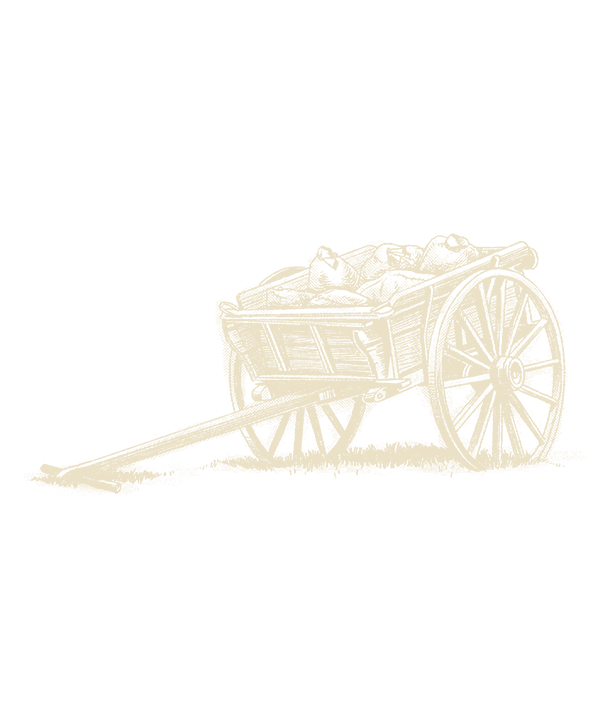
At times in American history the lives of “ordinary” individuals may become complicated and magnified by extraordinary relationships and circumstances. Such was the case of Patriot Mary Hemings of the famously enslaved Hemings family owned by Thomas Jefferson, chief author of the Declaration of Independence and third president of the United States of America. Mary Hemings’s status as a prisoner of war during the American Revolution demonstrated how involvement in the conflict, especially for women, could differ from the more common experience of direct combat and other kinds of active duty that more typically characterized the participation of Patriots of Color.
Mary Hemings was born in 1753, the oldest child of Elizabeth (Betty) Hemings, the matriarch of the Hemings family at Monticello, Virginia.1 Elizabeth and her 10 children, including Mary, became the property of Jefferson on January 14, 1774, following the division of the estate of Jefferson’s father-in-law, John Wayles.2 At Monticello, Mary worked as a household servant.3
Much of our knowledge of Mary Hemings during the American Revolution has come through the recollections of Isaac Jefferson. Isaac was the son of George Granger, Sr.—“Great George”—and Ursula Granger,4 both enslaved individuals at Monticello. As Isaac tells it, related through scholar Charles Campbell, when the “British (under [Benedict] Arnold) came to Richmond [VA],”5 where Jefferson was then living with his slaves while governor of Virginia in 1781, and could not find him, they “took all old master’s [slaves] from his house: all of em had to walk except Daniel & Molly (children of Mary the pastry-cook) & Isaac.”6 And these British forces “carred [sic] them all down to Little York (Yorktown.). . . Mr [sic] Jefferson’s people there was Jupiter, Sukey the cook, Usley (Isaac’s mother) George (Isaac’s father) Mary [Hemings] the seamstress & children Molly, Daniel, Joe, Wormley, & Isaac. . . It was very sickly at York: great many colored people died there, but none of Mr [sic] Jefferson’s folks.”7 However, later that year, “General Washington brought all Mr [sic] Jefferson’s folks . . . back to Richmond with him & sent word to Mr [sic] Jefferson to send down to Richmond for his servants. Old master sent down two wagons right away & all of em that was carred away went up back to Monticello.”8
Sources
Lucia Cinder Stanton, “’Those Who Labor For My Happiness’: Thomas Jefferson and His Slaves,” in Jeffersonian Legacies (Charlottesville, VA: University Press of Virginia, 1993), 148.
Lucia Cinder Stanton, “’Those Who Labor For My Happiness’: Thomas Jefferson and His Slaves,” in Jeffersonian Legacies (Charlottesville, VA: University Press of Virginia, 1993), 148.
“Mary Hemings Bell,” Monticello, accessed April 4, 2022, https://www.monticello.org/getting-word/people/mary-hemings-bell.
Isaac Jefferson and Charles Campbell, Memoirs of a Monticello Slave: As Dictated to Charles Campbell in the 1840s by Isaac, one of Thomas Jefferson’s Slaves, ed. Rayford W. Logan (Charlottesville, VA: University of Virginia Press, 1951), 4.
Isaac Jefferson and Charles Campbell, Memoirs of a Monticello Slave: As Dictated to Charles Campbell in the 1840s by Isaac, one of Thomas Jefferson’s Slaves, ed. Rayford W. Logan (Charlottesville, VA: University of Virginia Press, 1951), 16.
Isaac Jefferson and Charles Campbell, Memoirs of a Monticello Slave: As Dictated to Charles Campbell in the 1840s by Isaac, one of Thomas Jefferson’s Slaves, ed. Rayford W. Logan (Charlottesville, VA: University of Virginia Press, 1951), 19.
Isaac Jefferson and Charles Campbell, Memoirs of a Monticello Slave: As Dictated to Charles Campbell in the 1840s by Isaac, one of Thomas Jefferson’s Slaves, ed. Rayford W. Logan (Charlottesville, VA: University of Virginia Press, 1951), 20.

Though the story of Mary is an extraordinary one, she demonstrated how enslaved female Patriots could, on rare occasions, create lives of relative comfort and security depending on the status and influence of their owners, as well as their personal relationship to their owners.
In 1792, Mary successfully asked Jefferson if she could be sold to a white merchant, Thomas Bell, with whom she later entered into a common-law marriage.9 With Bell, she also birthed more children, and after Bell passed away in 1800, he left Mary and their children a considerable inheritance.10 Mary then lived with her children and grandchildren in a home on the main street of Charlottesville, Virginia, maintaining close bonds with her relations still at Monticello who remained enslaved.11 Due to her inheritance, she has the distinction of being the first Hemings to be manumitted and to own property in Charlottesville.12
Though the story of Mary is an extraordinary one, she demonstrated how enslaved female Patriots could, on rare occasions, create lives of relative comfort and security depending on the status and influence of their owners, as well as their personal relationship to their owners. Moreover, her experience in the Revolutionary War proved that enslaved women and their families were, at times, directly affected by the events of combat. Circumstances in her life would provide a buffer to the worst of the war’s upheavals, but it is important to recognize that she was uniquely situated and that other enslaved women and their families were not so fortunate. Nevertheless, her story has been cemented in the pages of history through her 2007 recognition by the Daughters of the American Revolution as a Patriot of Color.13
Sources
Isaac Jefferson and Charles Campbell, Memoirs of a Monticello Slave: As Dictated to Charles Campbell in the 1840s by Isaac, one of Thomas Jefferson’s Slaves, ed. Rayford W. Logan (Charlottesville, VA: University of Virginia Press, 1951), 20.
“Mary Hemings Bell,” Monticello, https://www.monticello.org/getting-word/people/mary-hemings-bell.
“Mary Hemings Bell,” Monticello, https://www.monticello.org/getting-word/people/mary-hemings-bell.
“Mary Hemings Bell,” Monticello, https://www.monticello.org/getting-word/people/mary-hemings-bell.
“Mary Hemings Bell,” Monticello, https://www.monticello.org/getting-word/people/mary-hemings-bell.
Lena Anthony, “Today’s Daughters: Family Ties,” American Spirit, January/February 2009, 4.
Sources
Lucia Cinder Stanton, “’Those Who Labor For My Happiness’: Thomas Jefferson and His Slaves,” in Jeffersonian Legacies (Charlottesville, VA: University Press of Virginia, 1993), 148.
Lucia Cinder Stanton, “’Those Who Labor For My Happiness’: Thomas Jefferson and His Slaves,” in Jeffersonian Legacies (Charlottesville, VA: University Press of Virginia, 1993), 148.
“Mary Hemings Bell,” Monticello, accessed April 4, 2022, https://www.monticello.org/getting-word/people/mary-hemings-bell.
Isaac Jefferson and Charles Campbell, Memoirs of a Monticello Slave: As Dictated to Charles Campbell in the 1840s by Isaac, one of Thomas Jefferson’s Slaves, ed. Rayford W. Logan (Charlottesville, VA: University of Virginia Press, 1951), 4.
Isaac Jefferson and Charles Campbell, Memoirs of a Monticello Slave: As Dictated to Charles Campbell in the 1840s by Isaac, one of Thomas Jefferson’s Slaves, ed. Rayford W. Logan (Charlottesville, VA: University of Virginia Press, 1951), 16.
Isaac Jefferson and Charles Campbell, Memoirs of a Monticello Slave: As Dictated to Charles Campbell in the 1840s by Isaac, one of Thomas Jefferson’s Slaves, ed. Rayford W. Logan (Charlottesville, VA: University of Virginia Press, 1951), 19.
Isaac Jefferson and Charles Campbell, Memoirs of a Monticello Slave: As Dictated to Charles Campbell in the 1840s by Isaac, one of Thomas Jefferson’s Slaves, ed. Rayford W. Logan (Charlottesville, VA: University of Virginia Press, 1951), 20.
Isaac Jefferson and Charles Campbell, Memoirs of a Monticello Slave: As Dictated to Charles Campbell in the 1840s by Isaac, one of Thomas Jefferson’s Slaves, ed. Rayford W. Logan (Charlottesville, VA: University of Virginia Press, 1951), 20.
“Mary Hemings Bell,” Monticello, https://www.monticello.org/getting-word/people/mary-hemings-bell.
“Mary Hemings Bell,” Monticello, https://www.monticello.org/getting-word/people/mary-hemings-bell.
“Mary Hemings Bell,” Monticello, https://www.monticello.org/getting-word/people/mary-hemings-bell.
“Mary Hemings Bell,” Monticello, https://www.monticello.org/getting-word/people/mary-hemings-bell.
Lena Anthony, “Today’s Daughters: Family Ties,” American Spirit, January/February 2009, 4.
More Patriot Profiles
Jack Congo
The course of the life of Jack Congo (alternatively, Congo Jack) showed how the relationship between slavery ...
Drury Walden
Perhaps surprisingly, there were Patriots of Color who enlisted in the American Revolutionary War as free men—even ...
Andrew Ferguson
The contribution of Patriots such as Andrew Ferguson reflected the distinct ways that certain independent Blacks could ...
